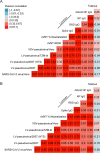Evaluation of Cell-Based and Surrogate SARS-CoV-2 Neutralization Assays
- PMID: 34288726
- PMCID: PMC8451402
- DOI: 10.1128/JCM.00527-21
Evaluation of Cell-Based and Surrogate SARS-CoV-2 Neutralization Assays
Abstract
Determinants of protective immunity against severe acute respiratory syndrome coronavirus 2 (SARS-CoV-2) infection require the development of well-standardized, reproducible antibody assays. This need has led to the emergence of a variety of neutralization assays. Head-to-head evaluation of different SARS-CoV-2 neutralization platforms could facilitate comparisons across studies and laboratories. Five neutralization assays were compared using 40 plasma samples from convalescent individuals with mild to moderate coronavirus disease 2019 (COVID-19): four cell-based systems using either live recombinant SARS-CoV-2 or pseudotyped viral particles created with lentivirus (LV) or vesicular stomatitis virus (VSV) packaging and one surrogate enzyme-linked immunosorbent assay (ELISA)-based test that measures inhibition of the spike protein receptor binding domain (RBD) binding its receptor human angiotensin converting enzyme 2 (hACE2). Vero cells, Vero E6 cells, HEK293T cells expressing hACE2, and TZM-bl cells expressing hACE2 and transmembrane serine protease 2 were tested. All cell-based assays showed 50% neutralizing dilution (ND50) geometric mean titers (GMTs) that were highly correlated (Pearson r = 0.81 to 0.89) and ranged within 3.4-fold. The live virus assay and LV pseudovirus assays with HEK293T/hACE2 cells showed very similar mean titers, 141 and 178, respectively. ND50 titers positively correlated with plasma IgG targeting SARS-CoV-2 spike protein and RBD (r = 0.63 to 0.89), but moderately correlated with nucleoprotein IgG (r = 0.46 to 0.73). ND80 GMTs mirrored ND50 data and showed similar correlation between assays and with IgG concentrations. The VSV pseudovirus assay and LV pseudovirus assay with HEK293T/hACE2 cells in low- and high-throughput versions were calibrated against the WHO SARS-CoV-2 IgG standard. High concordance between the outcomes of cell-based assays with live and pseudotyped virions enables valid cross-study comparison using these platforms.
Keywords: COVID-19; SARS-CoV-2; antibody; neutralization assay.
Figures


References
-
- Greaney AJ, Starr TN, Gilchuk P, Zost SJ, Binshtein E, Loes AN, Hilton SK, Huddleston J, Eguia R, Crawford KH, Dingens AS, Nargi RS, Sutton RE, Suryadevara N, Rothlauf PW, Liu Z, Whelan SP, Carnahan RH, CroweJE, Jr., Bloom JD. 2021. Complete mapping of mutations to the SARS-CoV-2 spike receptor-binding domain that escape antibody recognition. Cell Host Microbe 29:44–57. 10.1016/j.chom.2020.11.007. - DOI - PMC - PubMed
-
- Wu F, Wang A, Liu M, Wang Q, Chen J, Xia S, Ling Y, Zhang Y, Xun J, Lu L, Jiang S, Lu H, Wen Y, Huang J. 2020. Neutralizing antibody responses to SARS-CoV-2 in a COVID-19 recovered patient cohort and their implications. medRxiv 10.1101/2020.03.30.20047365. - DOI
-
- Huang AT, Garcia-Carreras B, Hitchings MDT, Yang B, Katzelnick LC, Rattigan SM, Borgert BA, Moreno CA, Solomon BD, Trimmer-Smith L, Etienne V, Rodriguez-Barraquer I, Lessler J, Salje H, Burke DS, Wesolowski A, Cummings DAT. 2020. A systematic review of antibody mediated immunity to coronaviruses: kinetics, correlates of protection, and association with severity. Nat Commun 11:14704. 10.1038/s41467-020-18450-4. - DOI - PMC - PubMed
-
- Long QX, Liu BZ, Deng HJ, Wu GC, Deng K, Chen YK, Liao P, Qiu JF, Lin Y, Cai XF, Wang DQ, Hu Y, Ren JH, Tang N, Xu YY, Yu LH, Mo Z, Gong F, Zhang XL, Tian WG, Hu L, Zhang XX, Xiang JL, Du HX, Liu HW, Lang CH, Luo XH, Wu SB, Cui XP, Zhou Z, Zhu MM, Wang J, Xue CJ, Li XF, Wang L, Li ZJ, Wang K, Niu CC, Yang QJ, Tang XJ, Zhang Y, Liu XM, Li JJ, Zhang DC, Zhang F, Liu P, Yuan J, Li Q, Hu JL, Chen J, Huang AL. 2020. Antibody responses to SARS-CoV-2 in patients with COVID-19. Nat Med 26:845–848. 10.1038/s41591-020-0897-1. - DOI - PubMed
Publication types
MeSH terms
Substances
Grants and funding
LinkOut - more resources
Full Text Sources
Medical
Miscellaneous

